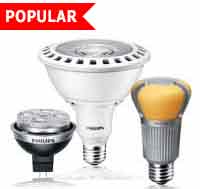Which Light Bulbs are the Greenest?
- For decades, those concerned with energy savings have been touting the benefits of compact fluorescent lamps (CFLs) over incandescents. CFLs use only one-fifth of the electricity of incandescents to generate the same amount of light, and they can last six to 10 times longer. But CFLs’ cooler color and inability to be dimmed have made them less desirable. Another hindrance to the widespread adoption of CFLs has been their higher cost (though most consumers would save plenty in energy costs over the life of a bulb). Also, CFLs contain mercury, a dangerous neurotoxin that is released when the bulbs break. And once CFLs do burn out they must be disposed of properly to avoid releasing mercury into the environment.Given the issues with CFLs, LEDs (short for light emitting diodes) are beginning to come on strong. These highly efficient bulbs don’t generate heat like incandescents (which helps to keep air conditioning costs down as well) and can last five times longer than CFLs and 40 times longer than incandescents. Tiny LED bulbs have been around for years in specialized applications (such as stadium scoreboards), but lighting engineers got the idea to cluster them and use reflective casings to harness and concentrate their light for residential use. In recognition of the LED’s potential, the U.S. Department of Energy (DOE) set up a special “solid-state” (LED) lighting R&D program to hasten the advance of the technology.
In comparing the total cost to run three different types of 60-watt equivalent bulbs for 50,000 hours (factoring in the cost of the both bulbs and electricity), the EarthEasy website found that LEDs would cost $95.95, CFLs $159.75 and incandescents $652.50. The 42 incandescent bulbs tested used up to 3,000 kilowatt hours of electricity compared to 700 and 300 for CFLs and LEDs respectively. However, despite the savings most consumers are loath to spend $35 and up for an LED bulb (even though it will save more than $500 in the long run) when a traditional incandescent bulb right next to it on the shelf costs $1.
There are other newer technologies in the works. Seattle-based Vu1 now sells highly efficient bulbs based on its Electron Stimulated Luminescence (ESL) technology, whereby accelerated electrons stimulate a phosphor coating on the inside of the bulb, making the surface glow. One of Vu1’s 65-watt equivalent bulbs retails for under $20 and uses a similar amount of energy as an equivalent CFL. And incandescents aren’t out of the efficient lighting race altogether just yet. Top bulb makers recently released new versions that use as much as a third less electricity to operate (complying with 2012’s new federal standards) and are promising newer models still that will run on even less energy.
Source for this article. HealthNewsDigest












Comments